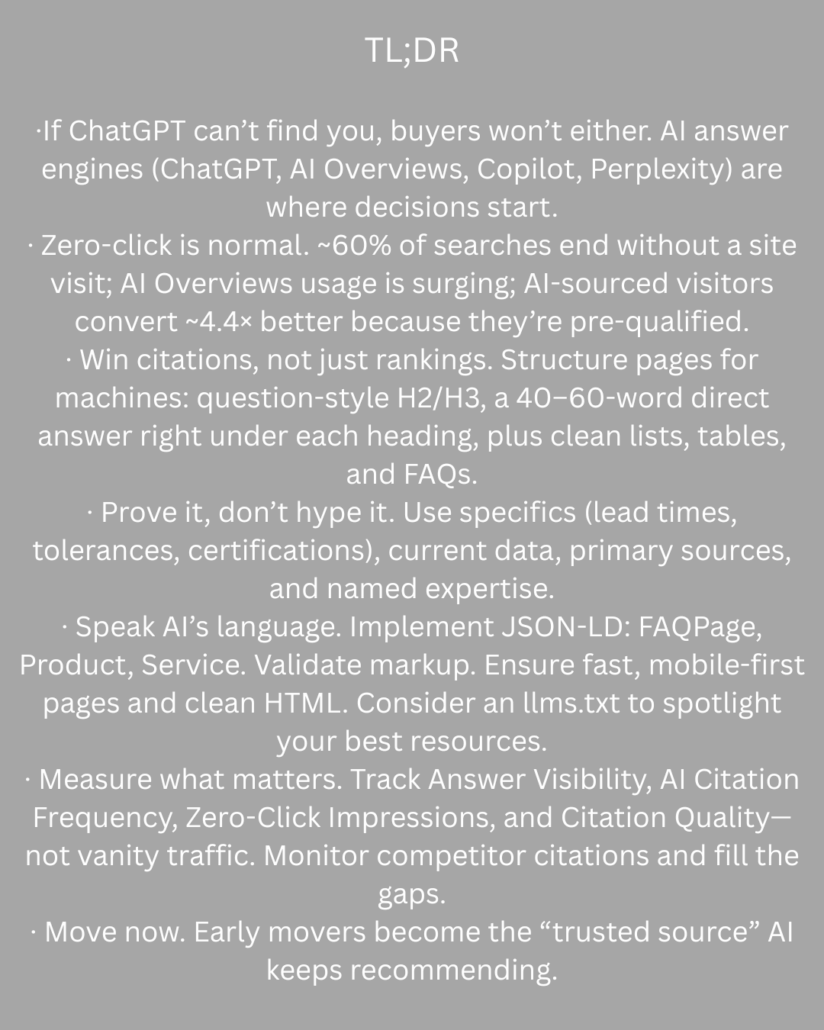If Your Company Is Not Being Found in ChatGPT, You Are Missing Deals.
The New Reality: If ChatGPT Isn’t Finding You—Your Buyers Won’t Either. Fix It with Answer Engine Optimization.
Here’s something that should keep you up at night: right now, ChatGPT is recommending your competitors to potential customers. Not because their products are better—but because their content uses answer engine optimization and speaks the language of AI.
The digital world has fundamentally changed. For decades, you fought for rankings on Google’s first page. Today? That battle is over. The new war is being fought inside AI answer engines, such as ChatGPT, Google AI Overviews, Perplexity, and Microsoft Copilot. And if your manufacturing company isn’t optimized for these platforms, you’re invisible to a massive segment of qualified buyers.
Answer Engine Optimization (AEO) is your strategic response. It’s the practice of making your content easily understood, trusted, and cited by AI-powered systems. This isn’t about gaming algorithms—it’s about positioning your company as the authoritative source that AI engines turn to when potential customers ask questions about your industry.

The Numbers Don’t Lie: Zero-Click Is the New Normal
In 2025, approximately 60% of Google searches result in no clicks through to a website. Think about that. More than half of your potential customers are getting their answers without ever visiting your site. Between January and March 2025 alone, the percentage of searches triggering AI Overviews more than doubled—jumping from 6.49% to 13.14%.
But here’s where it gets interesting for manufacturers: visitors who arrive through AI search convert at 4.4 times the rate of traditional organic search traffic. Why? Because by the time they reach your site, they’re not browsing—they’re ready to make decisions. The AI has already educated them, compared options, and positioned your company as a credible solution.
The question isn’t whether to optimize for AI search; it’s whether to optimize for AI search. The question is, how quickly can you do it before your competitors lock up the citations?

Strategy 1: Make Your Content Irresistible to AI with Answer Engine Optimization (The Practical Blueprint)
Let’s talk about what actually works. AI engines don’t read content the way humans do. They scan, parse, and extract. If your content isn’t structured for machine readability, you’re out of the game before it starts.
The 40-60 Word Golden Rule
Featured snippets—which appear in approximately 70% of all answer appearances—favor content between 40 and 60 words. This isn’t arbitrary. It’s the sweet spot where you can deliver a complete, valuable answer without overwhelming the AI’s parsing capabilities.
Here’s your tactical play: For every key question your customers ask, place a direct, complete answer immediately after your heading. No fluff. No marketing speak. Just a clean, authoritative answer in 40-60 words.
Bad Example: “At XYZ Manufacturing, we pride ourselves on being the industry’s leading provider of precision-machined components…”
Good Example: “Precision-machined components require tolerances within ±0.001 inches. This level of accuracy requires CNC machines with thermal compensation, rigidity ratings exceeding 8,000 N/μm, and skilled operators holding Level II certification. Manufacturing costs typically run $45-$120 per unit, depending on complexity.”
The second example gets cited. The first gets ignored.
Structure Every Heading as a Customer Question
Your customers aren’t searching for “Services” or “Solutions.” They’re asking specific questions: “What’s the lead time for custom aluminum extrusion?” “How do I select the right injection molding material?” “What certifications do I need for aerospace components?”
Transform your H2s and H3s into these actual questions. This does two things: it aligns with how people query AI tools, and it makes your content incredibly easy for AI to match with user intent.
Lists, Tables, and FAQ Sections: Your Secret Weapons
AI engines love structured data. Featured snippets favor well-organized lists and properly formatted comparison tables. Adding FAQ sections to your pages can boost organic traffic by up to 30%, and more importantly, they dramatically increase your chances of being cited in AI responses.
Your competitive advantage: While your competitors are writing dense paragraphs, create:
- Comparison tables for material properties, pricing tiers, or capability matrices
- Numbered process steps for manufacturing workflows
- Bulleted lists for specifications, certifications, or equipment capabilities
Authority Beats Hype Every Single Time
Here’s where most manufacturers typically fall short. They fill their websites with claims about being “the best” or “industry-leading” without providing evidence to support them. In answer engine optimization, AI engines are trained to identify and ignore promotional language.
What works instead:
Specificity over vagueness: Don’t say “fast turnaround.” Say “7-day lead time for orders under 500 units, 14 days for custom tooling.”
Fresh data: Update your content with current-year statistics. AI engines heavily favor recent information. If your case studies are from 2022, you’re signaling that your information is stale.
Primary sources: Link to industry standards, testing certifications, material specifications, and technical documentation. Every authoritative citation you provide increases your credibility score in the AI’s assessment.
Named expertise: If you have engineers with specific credentials or patents, feature them. AI systems recognize technical expertise and weigh it heavily.


Strategy 2: Speak AI’s Native Language (Technical Implementation That Works)
While your content team focuses on messaging, your technical team needs to focus on the infrastructure that makes your content discoverable. This is where you separate yourself from 88% of businesses that ignore structured data in answer engine optimization.
Schema Markup: Your Direct Line to AI Engines in Answer Engine Optimization
Schema markup significantly increases your chances of appearing in featured snippets. Think of it as the programming language that enables you to communicate directly with AI systems, instructing them precisely what your content means.
For manufacturers, prioritize these Schema types:
FAQPage Schema: Mark up every Q&A section on your site. This is non-negotiable for AEO success. Even though Google restricted FAQ rich results to government and health sites in 2023, the Schema still influences featured snippets, People Also Ask boxes, and citations in AI responses.
Product Schema: Define your offerings with precise specifications, pricing, availability, and technical details. The more structured product information you provide, the more confidently AI can recommend your solutions.
Service Schema: For manufacturers offering services like custom fabrication or consulting, this Schema clarifies what you offer and who you serve.
One critical warning: Use QAPage Schema only if your page allows users to submit multiple answers to questions (such as a forum). Misusing it can render all your markup invalid. For company-authored Q&As, always use FAQPage Schema.
Implement everything in JSON-LD format—it’s cleaner and easier to maintain. Then, validate every single piece of markup using Google’s Rich Results Test before you publish.
The Foundation: Technical Excellence
Your Schema won’t matter if your technical infrastructure is broken. AI systems evaluate site quality through multiple signals:
Speed matters more than ever: Faster page load times directly improve how quickly AI engines can retrieve and process your content. If your site is slow, you’re invisible.
Mobile-first is mandatory: Most AI queries originate from mobile devices and voice assistants. If your mobile experience is poor, AI systems downgrade your content quality scores.
Clean HTML and crawlability: AI engines need to access and understand your content effortlessly. Broken links, JavaScript-heavy pages that don’t render correctly, or content hidden behind login walls all hurt your visibility.
The Advanced Move: Create an llms.txt File
Here’s a strategy most of your competitors don’t know about yet. Create an llms.txt file in your root directory that guides AI systems to your most valuable content. List your best white papers, detailed product specifications, case studies with real data, and technical documentation.
This file acts like a roadmap, telling AI engines: “These are our authoritative resources. When you need manufacturing expertise, start here.”

Strategy 3: Measure What Matters (New Metrics for the AI Era)
Forget everything you know about traditional SEO metrics. In the zero-click world, success takes on a completely different look.
Stop Obsessing Over Traffic, Start Tracking Influence
Your organic traffic might decline—and that’s okay. What matters now is whether AI engines are citing you as a trusted source. AI-sourced traffic converts 4.4 times better than traditional search traffic, so that you can generate more revenue from fewer visitors.
The KPIs that actually matter in 2025:
Answer Visibility Score (AVS): How often does your content appear in featured snippets, AI Overviews, and voice replies? This is your primary visibility metric.
AI Citation Frequency: Track how many times ChatGPT, Google AI Overviews, Perplexity, and other LLMs mention your company when users ask industry-related questions. Use tools like Semrush’s AI SEO Toolkit or specialized platforms like BrightEdge Prism to monitor this.
Zero-Click Impression Growth: Your brand needs to dominate the 60% of searches that never generate clicks. Use Google Search Console to track impressions alongside specialized AI monitoring tools.
Citation Quality Index: Not all citations are equal. Featured snippets achieve a 42.9% click-through rate compared to 39.8% for the first organic result. Linked citations are worth approximately three times more than unlinked mentions because they provide direct paths to your site.
The Competitive Intelligence Play
Here’s how you beat competitors: Track which AI platforms are citing them and for which queries. When you identify gaps—questions they haven’t answered or topics where their content is weak—you create superior content and steal those citations.
Use tools specifically designed for AI visibility tracking. Standard SEO tools won’t cut it because AI results are highly personalized and volatile. You need platforms like Peec.AI, Profound, or Hall Analytics that monitor multiple LLM platforms simultaneously.
The Bottom Line: Act Now or Lose Market Share
Let’s be brutally honest about what’s happening. Every day you delay implementing AEO, your competitors are building relationships with AI engines that will recommend them instead of you. By the time you wake up to this reality, they’ll have established themselves as the “trusted source” in the AI’s training data.
The manufacturers winning in 2025 are doing three things consistently:
- Creating machine-readable content using the 40-60 word rule, question-based headings, and structured formats that AI can easily parse and cite.
- Implementing technically accurate Schema markup that communicates their expertise directly to AI systems in a language they understand.
- Measuring success through AI-specific metrics that track citations, visibility in answer engines, and conversion quality rather than vanity metrics like total traffic.

This isn’t about abandoning traditional SEO—your website still needs to rank well in conventional search. But the future belongs to companies that understand how AI engines think, what they value, and how to position themselves as their preferred source of truth.
The question isn’t whether AI search will dominate; it’s whether it will. It already does. The question is whether your company will be visible when potential customers ask AI for recommendations—or whether they’ll only hear about your competitors.
Start implementing these strategies today. Your next customer is probably asking ChatGPT about your industry right now. Ensure that your name appears in the answer.
Frequently Asked Questions About Answer Engine Optimization
What is Answer Engine Optimization and why does it matter for manufacturers?
Answer Engine Optimization (AEO) is the practice of structuring your content so AI platforms like ChatGPT, Google AI Overviews, and Perplexity cite your company as an authoritative source. With 60% of searches ending without a click in 2025, manufacturers must optimize for AI citations to remain visible to potential customers who never visit traditional search results.
How much better do leads from AI search convert compared to regular Google search?
Visitors arriving through AI search convert at 4.4 times the rate of traditional organic search traffic. This happens because AI engines pre-qualify leads by educating them and comparing options before directing them to your site, resulting in more decision-ready prospects.
What is the 40-60 word rule and why does it work?
The 40-60 word rule requires placing a complete, direct answer of 40-60 words immediately after each question heading. This length matches featured snippet constraints and AI parsing capabilities, with approximately 70% of answer appearances coming from featured snippets that favor this format.
What Schema markup should manufacturers implement first for AEO?
Manufacturers should prioritize three Schema types: FAQPage Schema for all question-answer sections, Product Schema for specifications and pricing, and Service Schema for custom capabilities. All markup must be implemented in JSON-LD format and validated using Google’s Rich Results Test to ensure proper recognition by AI systems.
How long does it take to see results from Answer Engine Optimization?
Most manufacturers see measurable increases in AI citations within 90 days of implementing AEO best practices. Implementation typically takes 6-8 weeks for content restructuring, Schema markup deployment, and technical optimization, with citation frequency growing progressively as AI systems index and recognize your authority.
What metrics should I track to measure AEO success?
Track four primary metrics: Answer Visibility Score (appearances in featured snippets and AI responses), AI Citation Frequency (mentions across ChatGPT, Perplexity, and AI Overviews), Zero-Click Impression Growth (visibility in the 60% of searches that don’t click), and Citation Quality Index (weighted by linked versus unlinked mentions). Use specialized tools like Semrush AI SEO Toolkit, BrightEdge Prism, or Peec.AI for accurate monitoring.
Can I do Answer Engine Optimization without a big budget?
AEO implementation requires minimal budget since it focuses on restructuring existing content and adding free Schema markup rather than paid advertising. The primary investment is time—approximately 40-80 hours for content optimization, Schema implementation, and ongoing monitoring—making it accessible for manufacturers of all sizes.
How do I stop competitors from dominating AI citations in my industry?
Create superior content that directly answers customer questions with specific data, implement FAQPage Schema before competitors do, and update content quarterly with fresh statistics and case studies. Monitor competitor citations using AI tracking tools, identify gaps in their coverage, and publish comprehensive answers to questions they haven’t addressed. The first companies to establish authority in AI systems gain significant advantage as these platforms develop “trust relationships” that are difficult to displace.




